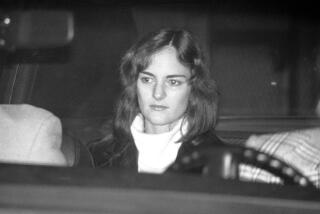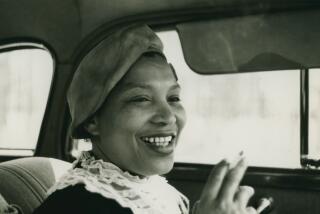Daughter Traces Builder’s Role at Hearst Castle
- Share via
A missing chapter in the annals of the storied Hearst Castle has come to light through the determined efforts of the daughter of a principal figure in the construction of the historic San Simeon landmark.
Milicent Patrick Trent, actress and illustrator, has just completed a yearlong search for evidence of the major role and work of her father, Camille Charles Rossi, who worked directly with publishing tycoon William Randolph Hearst.
Trent’s search for evidence of her father’s work and his crucial role in the building of the historic landmark gained momentum with a story in The Times (Jan. 27, 1985) about the existence of a collection of forgotten letters and plans of George Loorz who directed the later construction of Hearst’s grandiose pet project on the Hill.
Rossi is barely mentioned in most chronicles of the Hearst Castle, according to Trent, who spent 10 years at San Simeon as a child. One brief notation describes her father as “a flamboyant character given to fighting bulls on vacations in Mexico, who was superintendent of construction until the early 1930s.”
“He was flamboyant, all right,” Trent smiled. “But he was much more than that. He was an extremely colorful personality and a close friend of The Chief (Hearst). His input went beyond that of the builder and overlapped into the interior design and even in the choice of furnishings.
Life Like a Novel
“Not until I began reading some of the brochures on the castle, did I realize how little was known about my father, who worked for Julia Morgan and supervised construction of all the main existing structures from 1921 to 1932.”
The reference to fighting bulls in Mexico may not have been too far from the truth, Trent said. “My father was very young and daring in those earlier years in Mexico and his life style read like an Errol Flynn movie epic.”
After the 1906 earthquake and fire in San Francisco, Trent said, her father moved with his parents to Mexico City, and while in Mexico, climbed its two tallest volcanoes (a feat reported in a 1913 issue of National Geographic magazine), became Mexico’s national amateur fencing champion, and at 20, participated in the building the Theatro Nacional (now the Palacio de Finas Artes).
In 1912, Rossi traveled to San Francisco to marry his childhood sweetheart, but immediately returned to Mexico to construct La Boquilla Dam, second largest earthen dam in the world.
The Mexican Revolution was in full swing, and it became dangerous for Americans to remain. Rossi encountered Pancho Villa who confiscated his car for his own use, and after some hair-raising escapades, Rossi managed to get Villa to provide him with a letter of safe passage which he used to find his way back to San Francisco.
Though primarily self-taught, Rossi studied architecture at Mark Hopkins School of Design and was later enrolled in the California School of Design, then associated with the University of California at Berkeley.
In 1921, after a brief stint as a mining engineer in Peru, Rossi was hired by architect Julia Morgan, who needed an engineer and superintendent of construction for Hearst.
“My father worked on the drawings for the castle in Julia Morgan’s San Francisco office prior to arriving at San Simeon in 1922. At the time, only one permanent structure, the Casa del Mar, had been built. It was the first of the three guest cottages on the property,” Trent said. “Thereafter, my father built all the buildings that are there today.”
Received Lavish Gifts
Rossi became a close friend of The Chief--building, tearing down and rebuilding at Hearst’s whim. Hearst showed his appreciation with lavish gifts that included a gold evening watch, handsome luggage with silver fittings and a custom-built Studebaker.
Rossi started on the remaining guest cottages and finished them so that the Hearst family could visit San Simeon. After that, ground was broken for the main building.
The outdoor pool was completed about 1926, Rossi’s records show, and filled with water for Hearst’s inspection. Hearst reputedly told Rossi: “It looks a little too small, couldn’t we enlarge it?” and explained how he would like it curved out on both ends. The pool was torn out and rebuilt to suit Hearst’s wishes.
The indoor pool was fully completed in the late 1920s, but proved to be a disappointment because only a few guests enjoyed swimming indoors. The Filipino houseboys were the only ones who used it, Trent remembers. Eventually, it was drained and a wooden cover was built over it to prevent anyone from falling in.
“The Chief appeared to me like a mountain of a man with a gentle, almost feminine voice. He and father were good friends and father admired him greatly,” Trent said. “Father enjoyed pleasing him to the minutest detail and was often called upon to prove it.
Offending Tree Limb
“One afternoon Mr. Hearst, Cecil B. de Mille and father were strolling through the gardens along the many curving paths, when a low-hanging limb of a 400-year-old oak tree, unseen by Mr. de Mille, scratched his head enough to draw blood.
“Mr. Hearst was dismayed and turned to my father and asked that something be done about that limb. My father interpreted that Hearst meant to have a horticulturist remove the offending branch or to reroute the path to a more open area,” Trent related.
Nothing that simple had occurred to Hearst, however, Trent said. “The Chief simply asked my father: ‘Can you raise the tree about five feet and turn it around so that the limb would not overhang the walk?’ It was an impossible feat, no live oak tree had ever been moved and lived.”
Rossi tried anyway and, according to press reports of that time, became the first man to move an ancient oak covering about an acre with its shade, raise it and turn it around and have it live. The process used by Rossi was ingenious: The tree was moved together with a plot of earth 40 feet in diameter, nine feet deep. Around this was built a tub of concrete, 40 feet wide. The staves made of separate concrete blocks were held together by heavy bands of iron.
Tunneling under the earth, the soil and roots were supported from below by a criss-cross of concrete beams. The total weight moved with powerful jacks, exceeded six hundred tons. The feat won a great deal of acclaim for Rossi in the newsreels and in the press; he later moved other giant oaks in order to build additional structures on Hearst’s property.
Befriended Animals
Rossi’s records show an expenditure of about $50,000 a month on construction. Much of the activity centered on bear grottos and special quarters for Hearst’s collection of wild animals.
“My father had never had any experience with wild animals, but at San Simeon he became an animal trainer, of sorts,” Trent recalls. “He befriended all the animals, from the lion cubs to the giraffes. One baby leopard became an inseparable companion of my father and he called him Lepsy. Father, with his pet leopard on a chain, became a familiar sight on the Hill.”
In a letter to his daughter dated Aug. 8, 1958, Rossi answered additional questions regarding his personal recollections.
“The only authentic bed at San Simeon is the Henry VIII four-poster in the Gothic Suite. Then there are such beds as Cardinal Richelieu’s and Napoleon’s, etc . . . but these were all imaginary names given by me,” he wrote.
He also recalled some of the visiting dignitaries who were always part of the guest list. On his only visit to San Simeon, President Calvin Coolidge, who was noted for his lack of conversation, and Rossi had occasion to take the elevator together and to get stuck between floors. While waiting to be rescued, Rossi found that contrary to reports, Coolidge was an excellent conversationalist and possessed a droll sense of humor.
Return to San Simeon
“There was some wonderful statuary, mostly copies. Leon Gerome’s Pygmalion and Galatea stand out and a marble original on the entrance vestibule on the south side,” Rossi wrote his daughter. “There was a Venetian quatrefoil window for which Mr. H. paid $30,000. It was in the living room of the Doge’s Suite, so-called because it was Venetian-style.” Rossi also was an art connoisseur and selected many of the castle’s furnishings and statuary that were ordered from catalogues.
When the Depression hit and most of the major work had been completed at San Simeon, Rossi decided it was time to move on, but he remained a close friend of Hearst’s and visited him at the Marion Davies residence hours before Hearst’s death.
It was not until a few months ago that Trent returned to San Simeon--after so many years--with renewed interest and determined to set the record straight about her father. She also began searching for the few remaining people who had worked with Rossi, who might authenticate her father’s significant role in the building of the castle.
She located Maurice McClure of Oakland.
“I went to work on the Hearst Castle on Jan. 2, 1926, and it appears that Herbert Washburn had preceded Mr. Rossi in the early construction period and had completed the rough structures on the guest houses, plus much of the interiors of houses A and B. I don’t know why he left but I presume Julia Morgan felt that Mr. Rossi was a better construction supervisor.”
Bjarne C. Dahl of Los Altos, now 88, also verified the facts that Trent had assembled. “Your Dad and I were hired by Julia Morgan on the same day. He was also doing some of the drawings before he was sent down to San Simeon to become superintendent of construction. I am probably the last living person who can vouch for and who knew your Dad actually built the Castle.”
More to Read
Sign up for Essential California
The most important California stories and recommendations in your inbox every morning.
You may occasionally receive promotional content from the Los Angeles Times.






